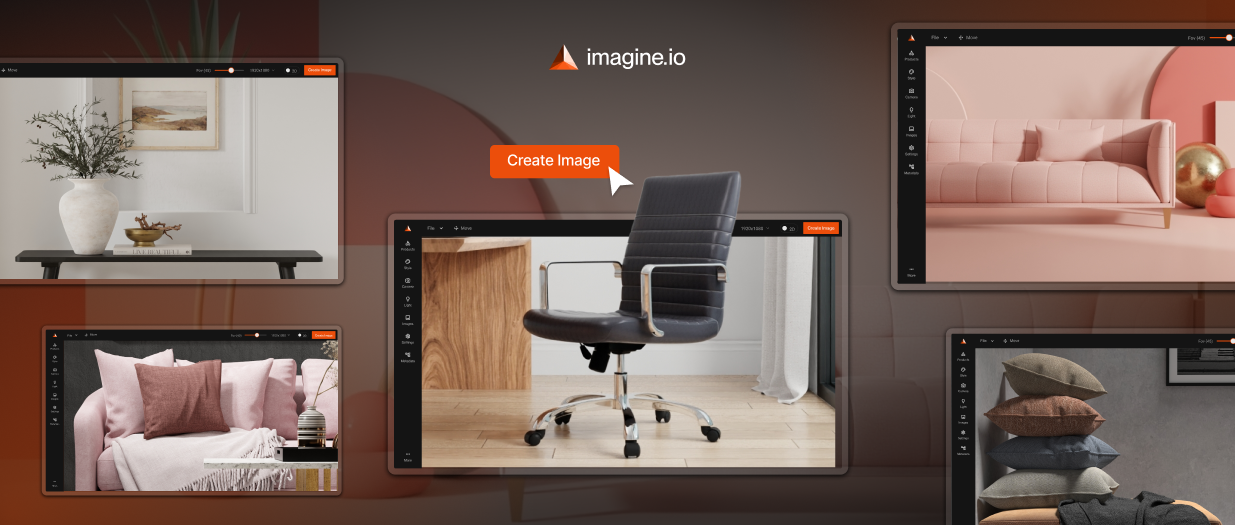In a digital-first world, product visuals can make or break a sale. Whether it's high-end furniture, electronics, or seasonal merchandise, compelling visuals are the foundation of engagement and conversion.
For years, creating high-quality product images meant labor-intensive photo shoots, extensive post-production, and long approval cycles. But today, a new era has begun—one driven by AI-powered automation.
From photorealistic renders to immersive AR experiences, artificial intelligence is reshaping how businesses create and deploy visual content. The benefits are profound: faster workflows, lower costs, scalable production, and personalized content—all without sacrificing quality.
Get the latest updates straight to your inbox.
By clicking sign up you'll receive occasional emails from imagine.io. You always have the choice to unsubscribe within every email you receive.
Visual Automation: Redefining the Shopper Experience
Today’s consumers expect dynamic, interactive visuals—not just static images on a white background. They want to zoom in, rotate, and even visualize products in their homes.
Visual automation, enabled by AI, meets these evolving expectations. At its core, it refers to the use of AI and machine learning to automatically generate, enhance, and distribute product visuals. Key capabilities include:
- Scalability: Eliminate the need for photoshoots for each SKU or product variant.
- Speed to Market: Produce visuals in hours instead of weeks.
- Cost Efficiency: Avoid expenses tied to physical samples and studio logistics.
- Personalization: Tailor visuals by region, season, or audience segment.
Key Technologies Powering AI Visual Automation
1. Generative AI for Visual Creation
Imagine uploading a 3D model and receiving a set of lifestyle images with different scenes, lighting, and angles—all without a single photoshoot. Generative AI makes this a reality.
By leveraging advanced techniques such as GANs and diffusion models, businesses can produce visuals that rival traditional photography. From modern urban lofts to rustic kitchens, AI enables the creation of rich, photorealistic environments that bring products to life.
2. Virtual On-Model Display
AI has revolutionized the way apparel and fashion items are visualized. Instead of traditional model shoots, brands can now display garments on diverse virtual models that vary in size, skin tone, pose, and more—instantly.
However, instead of focusing on fashion-specific platforms, businesses in home goods, accessories, and beyond are also exploring similar technology to provide relatable, inclusive, and cost-effective visuals. This approach reduces production time and enhances customer relatability without linking to niche industry competitors.
3. AI-Powered Image Optimization
Manual editing and platform-specific formatting are now a thing of the past. With AI-enhanced editing tools, businesses can:
- Automatically remove or replace backgrounds
- Adjust lighting, shadows, and reflections
- Apply consistent branding and visual styles
- Format images for different platforms with a single workflow
Rather than highlighting a range of external tools, many companies now rely on integrated platforms that handle everything from batch editing to brand styling in one place. This streamlines production and ensures consistency across channels.
Why It Matters: Business-Level Advantages
1. Enhanced Efficiency & Reduced Costs
AI allows lean teams to scale visual production rapidly—producing thousands of visuals without the overhead of a traditional studio. The result? Lower content costs, faster launches, and fewer logistical headaches.
2. Seamless Brand Consistency Across Channels
With centralized workflows and automated templates, businesses can ensure brand integrity across websites, marketplaces, ads, and in-store screens—delivering a unified customer experience.
3. Higher Engagement & Conversion Rates
Tailored, immersive visuals powered by AI are more engaging and relevant to consumers. Whether it’s a configurable product display or visuals that adapt to user preferences, these dynamic assets lead to higher click-through rates and reduced returns.
Real-World Adoption: A Glimpse at the Impact
From retailers streamlining content creation to eCommerce brands deploying 3D models and interactive spinners, AI-driven visual automation is being adopted across industries.
Platforms like imagine.io support a wide range of applications, allowing brands to produce lifestyle renders, videos, AR assets, and more—all from one centralized solution.
Challenges and Considerations
Despite its benefits, AI isn’t without challenges:
- Creative Limitations: Pre-set templates may not meet all design needs.
- Quality Control: Automated processes require review to avoid inaccuracies.
- Diversity and Inclusion: Biased training data can result in unrepresentative outputs.
- Integration Complexity: Bridging AI platforms with legacy systems may require effort.
The key is combining automation with human oversight—letting AI handle scalability while creative teams guide vision and storytelling.
The Road Ahead: AI’s Expanding Role in Visual Commerce
-
Real-Time Customization
Future-forward platforms will allow customers to customize products live on websites—adjusting colors, materials, or configurations in real-time 3D.
-
Voice-Guided Design Tools
AI is evolving to respond to natural language commands. Marketers might soon say, “Change this scene to a sunset view with a boho interior,” and instantly see it rendered.
-
Hyper-Personalized Visuals
AI will enable content to dynamically adapt to users based on location, preferences, and behavior. The same product might be presented in a winter-themed setting for one user and a tropical one for another.
-
Immersive AR and VR Shopping Experiences
As AR and VR become mainstream, AI will enhance these experiences with real-time rendering, object tracking, and contextual visuals—making online shopping more experiential than ever.
Conclusion: Visuals That Scale, Sell, and Stand Out
AI-powered visual automation is not just a tech trend—it’s a transformative shift. It empowers brands to produce beautiful, scalable, and relevant content faster than ever before.
For companies looking to stay competitive in today’s visual-first landscape, the message is clear: Embrace AI, and reimagine what’s possible.
Interested in exploring AI-powered visuals for your business? Book a demo and see how imagine.io is helping brands lead the visual revolution.


.png?width=1000&height=622&name=Internal%20-%20Key%20Technologies%20Powering%20AI%20Visual%20Automation%20(1).png)

.gif?width=1296&height=1296&name=Untitled%20design%20(8).gif)



.png?width=500&name=How%20to%20Add%20a%203D%20Product%20Configurator%20to%20Your%20WordPress%20Website%20(Complete%20B2B%20Guide).png)
















%20(1).png?width=500&name=Why%20Exploded%20Mattress%20Views%20Matter%20(And%20How%20to%20Generate%20Them)%20(1).png)
.png?width=500&name=Best%20Shopify%20Product%20Configurator_%20How%20to%20Choose%20the%20Right%20One%20(2).png)
.png?width=500&name=Why%20Exploded%20Mattress%20Views%20Matter%20(And%20How%20to%20Generate%20Them).png)



.png?width=500&name=Best%20Shopify%20Product%20Configurator_%20How%20to%20Choose%20the%20Right%20One%20(1).png)







.png?width=500&name=How%203D%20Rendering%20Can%20Make%20or%20Break%20Your%20Industrial%20Design%20Pitch%20(1).png)








%20with%20Digital%20Twins%20and%203D%20Visualization.png?width=500&name=Optimizing%20Your%20Digital%20Asset%20Management%20(DAM)%20with%20Digital%20Twins%20and%203D%20Visualization.png)




.png?width=500&name=Styling%20Home%20Decor%20for%202025_%20From%20Global%20Influences%20to%20Playful%20Personalization%20(1).png)

